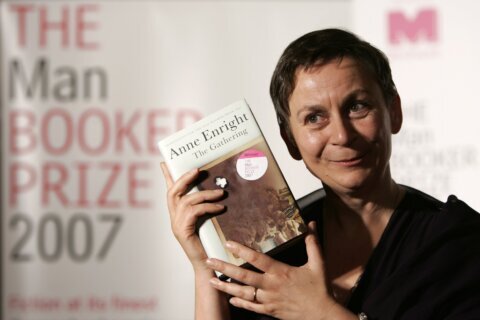WASHINGTON — For the past week, you couldn’t scroll through social media without seeing your friends publicly declare their binge-watching obsession with Netflix’s “Making a Murderer.”
The documentary series began streaming Dec. 18, inspiring a petition of nearly 130,000 signatures and a White House response that it couldn’t get involved because it was not a federal case.
Likewise, many of those same social media posts included comparisons to NPR’s podcast “Serial,” which just entered its second season, and HBO’s “The Jinx,” which aired from Feb. 8 – March 15 and won two Primetime Emmys, including Outstanding Documentary Series.
The entire phenomenon has us wondering: What breeds our obsession with true-crime shows? What impact do these shows have on the criminal justice system? And why the recent cultural explosion?
Before we dive into those questions, here’s a quick summary of each show.
‘Making a Murderer’
“Making a Murderer” is a ten-part Netflix documentary created by Laura Ricciardi and Moira Demos. It follows the story of Steven Avery of Mantiwoc County, Wisconsin, who served 18 years in prison for sexual assault and attempted murder before being exonerated in 2003. It then plunges into his 2005 arrest and trial in the murder of Teresa Halbach, a local photographer who was last seen on his property, as well as the prosecution of his nephew Brendan Dassey as a potential accomplice.
‘The Jinx’
Similarly, “The Jinx” follows Robert Durst, heir to a Manhattan real estate fortune, who was accused of orchestrating the 1982 disappearance of his wife Kathie, the 2000 murder of friend Susan Berman in Los Angeles, and the 2001 dismemberment of neighbor Morris Black in Galveston, Texas.
The six-part HBO series was written and directed by Andrew Jarecki, who previously directed the narrative film “All Good Things,” loosely based on Durst’s life, which starred Ryan Gosling and Kirsten Dunst. After seeing that film, Durst contacted Jarecki to express admiration for his insightful storytelling and agreed to sit down with him for 20 hours after decades of dodging the media.
Granted, this sort of true-crime filmmaking is nothing new, sparked by Errol Morris’ documentary “The Thin Blue Line” (1988), which got a wrongfully-accused Texas inmate, Randall Dale Adams, off death row with its groundbreaking blend of re-enactments and prison interviews. The format really entered the mainstream with TV shows like “Unsolved Mysteries” and “America’s Most Wanted,” and continues with investigative journalism pieces from PBS’ “Frontline” to CBS’ “60 Minutes.”
So with a plethora of past examples, the question becomes: why the sudden explosion?
“The word ‘binge watch’ didn’t use to be in our vocabulary and now it is. Combine that with the true-life things that have been happening, starting with the case in Ferguson and Baltimore and Staten Island and South Carolina and Cleveland, where there’s video that has gotten people talking and social media ginned up over these things,” says Washington Post crime reporter Tom Jackman.
Jackman has been covering courts and cops for about 30 years between The Kansas City Star and The Washington Post, where he heavily covered the John Geer case in Fairfax County.
“This Avery case, the trial was in 2007. The crime was committed in 2005. It was a large intervening time there and the filmmakers have even said it’s a good thing it took us so long to make this, because by the time we were ready, the world was ready. … They originally pitched it to HBO and PBS, who both passed on it, then ‘Serial’ and ‘The Jinx’ came out … and that created a demand for more.”
As an adjunct professor at George Mason University, where he teaches a course called “Media Coverage of Criminal Justice,” Jackman says “Murderer” carries a clear agenda: to exonerate Avery.
“Mainstream media journalists … we’re not supposed to have an agenda. We’re supposed to play it down the middle. But an independent filmmaker — or filmmakers in this case — they’re allowed to adopt any agenda they want if they can sell it, as long as they’re transparent about it. In this case, they have said, ‘We just went to Wisconsin because it was an interesting story and we wanted to tell it.’ That is a sort of journalistic outlook, but the problem being that they then embedded with one side, that being the defense, and the story is largely presented from the defense point of view.”
The defense is compelling with several suspicious findings, namely that a crucial piece of evidence — the key to the victim’s car — wasn’t found in Avery’s bedroom until the seventh police search.
Which defense arguments are the strongest in Jackman’s seasoned opinion?
“I thought the most compelling thing for the defense was that this was supposedly a horrible, vicious murder and there’s virtually no trace of it in the house or in the garage, (only) small minor traces, which they found. As horrible as this attack was made out to be, the evidence is mighty sparse and the confession that came from the teenage nephew did not look on the up-and-up to a lot of people.”
On the flip side, what is the prosecution’s strongest argument?
“They would point out, alright, you claim that we stole blood from the evidence in the first case and planted it in Teresa’s car, well how did we get DNA? How did we get DNA inside the hood of her car, and how did we get DNA on her key, and how did we get her key, and how did it get there?”
The documentary also leaves out the fact that Avery called the victim three times that day.
“Teresa had been to that house before and had been a little bit spooked by Avery, and he had specifically called and asked for her to come back and had used the “Star 67″ phone trick to conceal his identity in making the call,” Jackman says.
Overall, Jackman finds it bizarre that both the defense and prosecutors were allowed to speak with TV reporters from the local media after each day of the Avery and Dassey trials.
“It’s very unusual. It happened in the (D.C.) Sniper Case. We’re down in Chesapeake for the Malvo case, and the defense would come out each day and talk to us in the tent outside the courthouse, but that’s because there were no cameras in the courtroom. Here (in the Avery case), there were cameras in the court, so I don’t know what excuse the media had for grilling them again when things had already been done in court. As a reporter, I’m happy to have access to the lawyers … but should they be commenting on the evidence during a trial is questionable and doesn’t happen very often.”
Rare or not, it provided some juicy reaction shots for the filmmakers, who cut away to unconvinced journalists with furled eyebrows as they grill the attorneys. Ricciardi and Demos also deserve credit for creatively using B-roll of crunched cars to break up the more dry court-room footage, not to mention compelling cliffhangers as key pieces of evidence that send us into the credits.
Best of all, the show raises serious questions about the criminal justice system. Regardless of whether Avery committed the alleged crimes — or whether Mantiwoc County did anything nefarious — “Murderer” offers giant red flags as to the potential for planted evidence, coerced confessions and wrongful convictions, showing why criminal justice reform has become such a bipartisan issue lately.
“I thought it was brilliant filmmaking, in part because they had exceptional access to the players involved … strategizing about the case, that’s fantastic behind-the-scenes insight. Then you’re with the family, they’re going to the jail, and you’re talking to the defendant every day … They had great access and were able to parlay that into a really compelling story. Now what would have happened if they had access to the prosecution side? Boy, that would have been the best thing ever.”
In the end, the holes in the prosecution and the defense make us feel like we’re never getting the full story from either side in “Making a Murderer.” This is what makes “The Jinx” more fulfilling in my opinion. In structuring his “Jinx” documentary, Jarecki includes interviews with Durst’s skeptics — family, friends, lawyers and journalists who think Durst is guilty — juxtaposed against Durst’s own first-person defense complete with witty responses, facial ticks and artificially dilated pupils.
Not until the end does Jarecki elect to take a side in his subject’s innocence or guilt, building to an earth-shattering climax that will make your jaw hit the floor in one of the most powerful moments in TV history. Watching it, you’ll recall the dry-heaving of Anwar Congo in Joshua Oppenheimer’s documentary “The Act of Killing” (2012). The truth will set you free; or it may make you vomit.
What elevates “The Jinx” beyond a gripping in-the-moment show to an all-time classic are the thematic layers hinted at in its genius title. Not only does the “The Jinx” foreshadow its own powerful twist, it also speaks to the core of Durst’s patriarchal fears. There’s a scene where Durst describes forcing his wife to get an abortion because he didn’t want to be a “jinx” to his kids, having already suffered his own haunting childhood. Yet it’s this exact “jinx” — fear of repeating his parents’ mistakes — that sparks his own crumbling marriage, snowballing into a string of alleged crimes.
This is a Corleone-style tragedy of wanting to not become your father so much that you ironically become worse than he could have imagined. This is why “The Jinx” deserves to be held in the same class as “The Godfather” for their respective fields; one documentary, one narrative. It speaks to the cyclical nature of our inner familial demons, all masked within a gripping rollercoaster ride.
In short, if you enjoyed “Making a Murderer” even a little, “The Jinx” will blow you away.
Listen to the whole interview with Tom Jackman below. May contain some spoilers.







